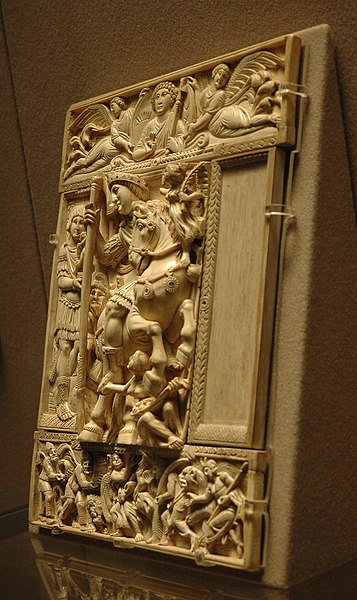The Barberini ivory is a Byzantine ivory leaf from an imperial diptych dating from Late Antiquity, now in the Louvre in Paris. It represents the emperor as triumphant victor. It is generally dated from the first half of the 6th century and is attributed to an imperial workshop in Constantinople, while the emperor is usually identified as Justinian, or possibly Anastasius I or Zeno. It is a notable historical document because it is linked to queen Brunhilda of Austrasia. On the back there is a list of names of Frankish kings, all relatives of Brunhilda, indicating her important position. Brunhilda ordered the list to be inscribed and offered it to the church as a votive image.
Barberini ivory on display at the Louvre
The triumphant emperor on the central panel
Solidus of Constantine II, minted in Heraclea between 326 and 330.
3/4 view, underlining the different depths of relief on the Barberini ivory.
A diptych is any object with two flat plates which form a pair, often attached by a hinge. For example, the standard notebook and school exercise book of the ancient world was a diptych consisting of a pair of such plates that contained a recessed space filled with wax. Writing was accomplished by scratching the wax surface with a stylus. When the notes were no longer needed, the wax could be slightly heated and then smoothed to allow reuse. Ordinary versions had wooden frames, but more luxurious diptychs were crafted with more expensive materials.
Ivory consular diptych of Areobindus, Byzantium, 506 AD, Louvre
Wax tablet and a Roman stylus
Barberini Ivory, Constantinople, 6th century, Louvre
Diptych with the Coronation of the Virgin and the Last Judgment, Metropolitan Museum of Art








